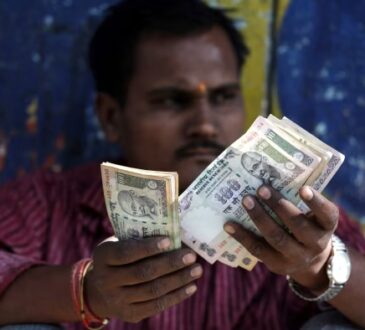Asian stocks battled to hold ground on Tuesday after a furious flight from US assets undermined Wall Street and the dollar, while concerns about the independence of the Federal Reserve piled fresh pressure on Treasuries.
Relatively limited losses in Asia did spark talk that funds could be reallocating money to equities in the area, though the impact of tariffs on economic growth remained a major drag.
President Donald Trump’s increasingly vocal attacks on Fed Chair Jerome Powell for not cutting interest rates saw Wall Street indexes shed around 2.4 per cent on Monday and the dollar hit three-year lows.
“The ‘sell America’ trade was in full flight,” said Tapas Strickland, head of market economics at NAB.
“Whether or not President Trump is legally able and willing to move against the Fed, the jousting underscores the loss of US exceptionalism and the very real policy risk for investors.” The selling did abate somewhat in Asia, allowing S&P 500 futures to bounce 0.3 per cent and Nasdaq futures 0.4 per cent.
The market faces another test from earnings this week, with 27 per cent of the S&P 500 due to report. Tesla is due later in the session, having already shed almost 6% on Monday amid reports of production delays.
Others out this week include Alphabet and a host of high-profile industrials including Boeing, Northrop Grumman, Lockheed Martin and 3M.
The fallout from Wall Street still only saw Japan’s Nikkei ease a slim 0.2 per cent, while MSCI’s broadest index of Asia-Pacific shares outside Japan held steady.
Chinese blue chips added 0.2 per cent as Beijing warned other countries against striking trade deals with the United States at China’s expense.
European shares also saw restrained losses, with futures for the EUROSTOXX 50 and DAX down 0.5% and FTSE futures off 0.1%.
LOSING FAITH Yields on US 10-year notes edged up further to 4.43% on fears the White House could try and replace Powell with someone more inclined to cut rates, even as inflation was being lifted by Trump’s swingeing tariffs.
There was also the concern that the current Fed might now be more reluctant to ease policy in case that was perceived as giving into political pressure.
While White House talks on various trade deals are underway or about to start, a quick resolution seemed unlikely. Analysts at JPMorgan noted the average trade deal took 18 months to negotiate and 45 months to implement.
“We reiterate our view that if current policies do not change, then the probability of a US recession in 2025 is 90%,” they said in a note.
The loss of confidence in US assets took a heavy toll on the dollar which touched its lowest since March 2022 against a basket of currencies at 97.923 on Monday.
The currency hit a decade-low on the Swiss franc at 0.8042, while the euro broke above $1.1500 to reach $1.1538. The dollar struck a seven-month trough on the yen at 139.92, and looked set to test a low form last September at 139.58.
“The independence of the Federal Reserve is a cornerstone of the dollar’s credibility,” noted Quasar Elizundia, a research strategist at broker Pepperstone.
“The dollar’s status as the ultimate safe-haven asset can no longer be taken for granted; it is being actively challenged.” The weakness in the dollar combined with demand for physical safe havens helped gold to another record above $3,485 an ounce.
Oil prices have been going the other way as worries about a global slowdown met the prospect of increased supply from OPEC.
There was a slight short-covering bounce on Tuesday as Brent rose 45 cents to $66.70 a barrel, while US crude added 65 cents to $63.73 per barrel.
Singapore stocks rose for a sixth straight session on Tuesday, marking their longest winning streak in over four months, while recent gains in emerging Asian currencies fizzled out as the dollar steadied after a sharp drop. Singapore’s Straits Times index rose up to 1.7 per cent, their highest since April 4, driven by top banks DBS Group and Oversea-Chinese Banking Corp. The city-state’s defensive and high-yielding stocks, once sidelined for their limited growth outlook, have drawn renewed interest from foreign investors seeking steadiness through rampant volatility.
“Singapore can be viewed as a safe haven in the current turbulent environment. It has an attractive dividend yield, resilient currency and multi sectors that are not directly exposed to tariffs,” said Paul Chew, Head of Research at Phillip Securities. Investors were likely to remain focused on defensive sectors, with global markets expected to stay volatile in the coming months, said Carmen Lee, Head of OCBC Investment Research.
Elsewhere in Southeast Asia, markets were mixed, with Jakarta up 0.9 per cent and Bangkok flat, while Taiwan fell 1.6 per cent to a near two-week low, tracking weak cues from Wall Street.




